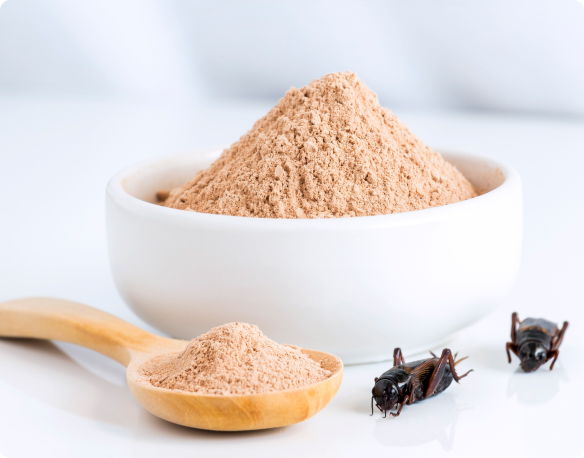
Cricket flour: between innovation and perplexity
Cricket flour (Fig. 1) and minor meal larvae made their formal market debut as "food" on January 24 and 26, 2023. After the yellow larvae of the meal (Tenebrio molitor) and common locusts, these are the second and third products of this sort (edible insect meals) that EFSA (European Food Safety Authority) has approved (Locusta migratoria).

European legislation
The launch of the sale of these foods coincides with the release of the EU Regulation on “novel food” (Fig.3 Examples of “novel food”. [Source: BRIGITTE] ),which came into effect in January 2018 and under which EFSA is in charge of evaluating the risks and advantages of these products.
The term “novel food” does not refer to a contemporary phenomena; in reality, over the years, numerous new meals have made their way to European tables as a result of migrant movements, expeditions, and vacations.
Bananas, exotic fruits, chocolate, tomatoes, potatoes, corn, and rice come to mind.
However, from a regulatory perspective, all foods that were not regularly consumed in Europe before to May 1997 are regarded as “novel foods.”
Therefore, “new foods” include foods enhanced with omega-3, plant sterols, krill oil, and chia seeds (Fig.4 Chia seeds.[Source: nonsolobenessere.it]) .

In which products can be found
Because it is gluten-free, cricket flour can be used with other flours to make baked goods, crackers and breadsticks, dry biscuits, spaghetti, potato products, whey powder, beer-like drinks, and chocolate items.
Given that it is composed of proteins with a high biological value, this new type of flour really serves as an addition that can increase the protein content of dishes (they contain all the amino acids that the body needs).
It also contains significant amounts of iron, calcium, and vitamin B12, all of which support bone development and guard against megaloblastic anemia and iron insufficiency.
Questions and dilemmas
There hasn’t been much interest in this phenomenon, which is even seen to be hazardous, in several European nations, including Italy.
In fact, a Coldiretti survey found that 54% of Italian consumers disagree with Brussels’ actions and saw them as a direct attack on the Mediterranean diet.
Insect proteins can also cause allergic reactions (Fig.5 Table of allergens that currently must be declared on the label.[Fonte: mensapiodecimo.eu]) which is why they must always be listed on the label among the other allergens that have already been identified.

In-depth: other novel foods
The full list of foods that have been authorized or disapproved by EFSA is available (for individuals who are interested in the realm of “new foods”) on the EU website, specifically in the “Food Safety” section.
Examples of items in this list are:
- Spirulina: a blue-green microalga that the Aztecs have consumed for centuries. It is sold today as pills, powders, and flakes and is used as a source of vitamin B12, which improves the immune system, protects the liver, and avoids allergies.(Fig.6 Alga spirulina. [Source: essentialnutrition.com.br]);
- Black cumin(Nigella sativa): an annual herb belonging to the Ranuncolaceae family, is prized for its seeds’ abundance of proteins, alkaloids, saponins, and lipids.(Fig.7 Black cumin. [Source: improntaunika.it]);
- Lucerne (Medicago sativa): a native of western Asia leguminous plant, it is frequently used as a source of feed for ruminant animals.(Fig.8 Medicago sativa (lucerne) [Source: infonortedigital.com]).

Sources
- Novel food catalogue (europa.eu);
- Spirulina (humanitas.it);
- Farina di grillo fa male? È cancerogena? Ecco le info e il prezzo | Gazzetta.it;
- Farina di grillo e larve, via libera alla vendita in Ue: in quali cibi si potranno usare (msn.com);
- Farina di grilli: come usarla in cucina – Grilli in polvere, il nuovo cibo ricco di proteine e povero di grassi: guida all’utilizzo Cook – Cucina Corriere.it.